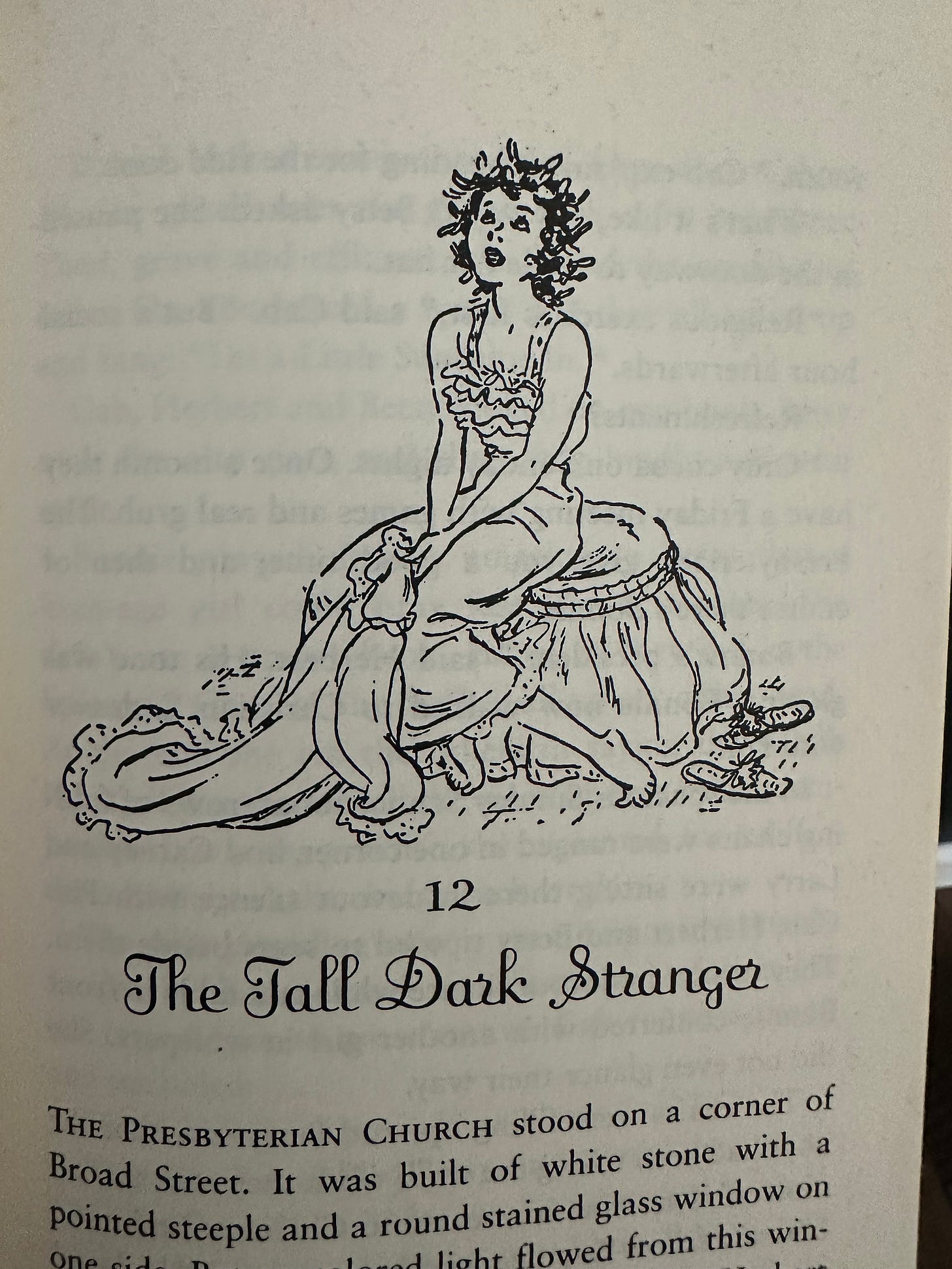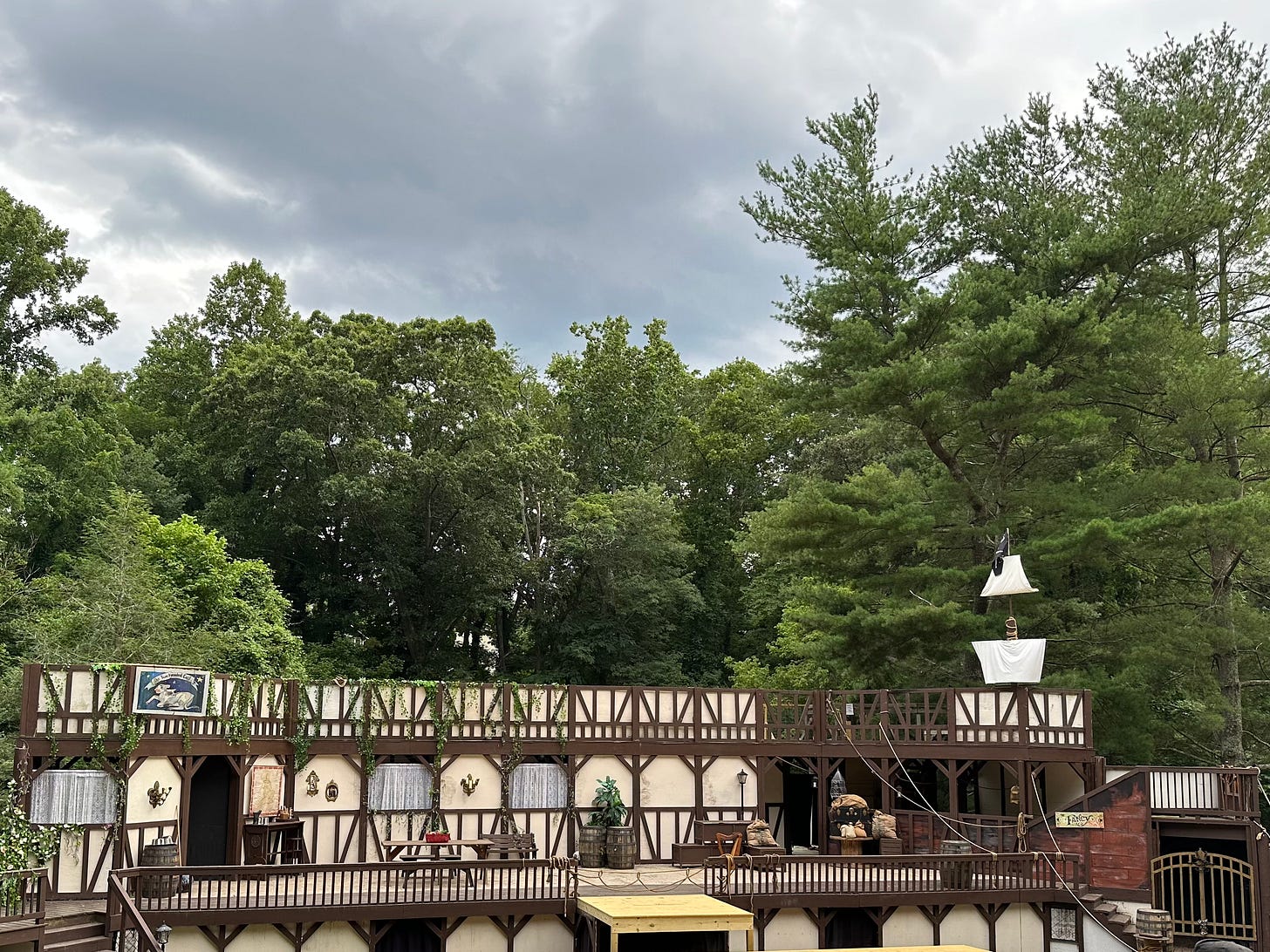Blame Betsy
I am probably the only person in the world who became an Episcopalian because of a children's book set in Minnesota in 1906
As promised, here is part one of my extremely niche-interest mini-series on why I am an Episcopalian and what I love about The Episcopal Church.
When I was a child, my dad read to me every night before bed. He read Little House and Narnia and Rebecca of Sunnybrook Farm and Wee Sir Gibbie of the Highlands. He read at least some of the Betsy-Tacy books, maybe all; and then I read them myself, and then I read them again every year, for maybe a decade.
It’s hard to say what it was about these books. I was living a middle class life in San Antonio in the 1980s; they transported me to small-town Minnesota in the 1890s. In the very first scenes, Betsy, age 5, is watching a new family of Irish Catholics move in across the street. Her initial attempts to befriend their shy red-headed daughter fail, but the next day the two have a picnic and then are best friends for life.
In the early books, Betsy and Tacy (and then also Tib and a small group of other neighborhood kids) don’t do anything extraordinary. They climb trees and pretend to be birds. They put on a play in their backyard. They make friends in the Syrian immigrant community in the next town over (I wrote about this a long time ago!). They go Christmas shopping downtown without their parents. They climb a big hill, and form a secret club, and drink hot cocoa after playing in the snow. and fight with their sisters. Somehow, for me, it was magic.
Then, in the high school books, Betsy goes about with a “Crowd” of boys and girls. If I thought high school would be about dance cards and Greek clubs and essay contests and hair in pompadours and everybody over at my house singing songs around the piano, it was because of these books.
I can’t emphasize enough that the Betsy-Tacy books are not religious fiction; they are about a girl figuring out who she is, and they are mostly about friendship and crushes and fashion and ambition. But they are set in small-town Minnesota a hundred and twenty years ago, and so of course religion threads its way through things.
The kids in Betsy’s crowd don’t all belong to the Baptist church, like she does. Some are Presbyterian, and most of them attend the “Christian Endeavor” youth group at the Presbyterian church regardless of where they go on Sunday mornings. (This youth group is primarily important in the books as the place where Betsy first encounters the Tall, Dark, and Handsome Tony Markham.)
And a few are Episcopalian; Betsy’s older sister Julia, who hopes to become a professional opera singer, sings in the choir in the Episcopal church, and she wants Betsy to join.
“I’d love to!” cried Betsy. She thought rapturously of wearing vestments and of marching through candlelight…
“Do you suppose Papa and Mamma would mind?” asked Betsy after a thoughtful moment. “They don’t mind your doing it because you have such a talent for music, and they know it’s good training. But they might not like to have me going all the time to the Episcopal Church.”
“They’d still have Margaret to go to the Baptist Church with them,” said Julia. She turned from the mirror to look solemnly into Betsy’s face.
“Bettina,” she said. “I love the Episcopal Church. I want to be an Episcopalian.”
“Julia!” cried Betsy, hardly believing her ears.
“I don’t think I was ever cut out to be a Baptist,” Julia said.
Betsy was genuinely shocked. It had not occurred to her that one could change one’s church any more than one could change one’s skin. (106-107)
Betsy begins to wonder if she is cut out to be a Baptist; she feels most religious not at church but when praying alone, or writing poetry, or talking to Tacy about God. But she and Julia are not at all sure their parents will approve. When the whole family visits, to hear the girls sing, Mr. Ray grumbles “All that kneeling down and getting up, kneeling down and getting up!”
After a few months, Betsy’s love of the church has deepened; it’s no longer just about the clothing and candles; she loves “the kneeling down to pray and the standing up to praise”... she loves the canticle that calls upon “Angels, Heavens, Waters that be above the firmament, Sun and Moon, Showers and Dew…” and the way that “the panorama of the earth and seasons seemed to wheel majestically before her eyes.” (155)
At Christmas, Betsy finds the music of the hymns filling the “empty chilly church with a glory like golden light.” When she goes to the unlit nave to pray while Julia is practicing a solo, she prays that she’ll grow prettier and that Tony will love her and that she’ll grow up to be a writer.1 At Lent, she and Julia take up lenten disciplines for the first time.
Betsy and Julia begin to devise a plan to break the news to their parents. On the morning they choose, they say a special prayer together, and then after his Sunday afternoon nap, they approach their father, who is startled and begins making jokes.
“Papa,” said Betsy, “don’t joke. Julia and I know that you’ll feel terrible. In the first place it will be so embarrassing to you; you’re a prominent Baptist…” (263-264).
Her father pauses, and then sets them straight: what other people will say doesn’t matter at all. After all, he and their mother have done plenty of things the Baptists don’t approve of (“we belong to a dancing club; we play whist; we go on picnics sometimes on Sundays.”). Betsy also feels bad because her father’s mother started a Baptist church in Iowa; she feels like she’s rejecting a family legacy. But Mr. Ray isn’t worried about that. He simply asks them what makes them want to be Episcopalians, and Julia answers.
“It’s the beauty of the service, Papa,” she said. “Betsy and I both respond to it. The music lifts us up, and the ritual is like a poem.”
When they assure their father that this isn’t a whim, but something they’ve thought about for a long time, he says he knows their grandmother would approve, and he does too. He hopes they’ll be “good Episcopalians” and that they’ll support the church with money and with time, and most of all that they’ll be people of character: of kindness, honesty, and unselfishness. He gives them his blessing.2
The truth is that the first thing that drew me to the Episcopal Church was nothing more than this: an imaginary vision of a hushed, dimly lit nave, candles flickering and robes swishing, prayers more like poems and paeans to creation, music that made the room glow.
From the time I was about ten years old, I had a sense that the Episcopal church was a place of beauty –
And while it was primarily Betsy who gave me that, it wasn’t only her. I fell asleep listening to The Chronicles of Narnia on cassette, stories deeply formed by CS Lewis’s Anglican faith (as well as ancient mythology and fairy tale). I was fascinated by Canon Tallis, a priest who was part James Bond and part Father Brown, a crossover character who showed up in both the O’Keefe and Austin family novels by Madeleine L’Engle (another Episcopalian!). L’Engle’s stories made science spiritual for me, and her characters prayed prayers that reminded me of the Benedicte. (If Emily of New Moon and Jo March had been Episcopalians too, it would have all been over for me even faster.)
When I was a teenager, I went to a church with stadium seating and purple and teal accent walls, and I loved it. But I took the Book of Common Prayer off my parents’ bookshelf at home, and kept it in my room. I heard from the adults in my life that the Episcopal church was full of people who didn’t actually believe in the resurrection, people who didn’t take the Bible seriously enough to keep women out of the pulpit. So I read my prayers alone, from time to time, and I read A Ring of Endless Light and At Home in Mitford and “The Collar” (you can actually find this poem inscribed in the front of one of my high school journals, though I had no idea its title referred to a clerical collar; I just loved the way it began: I struck the board, and cried, "No more;/I will abroad!/ What? shall I ever sigh and pine?/My lines and life are free, free as the road,/Loose as the wind, as large as store.).
And then when I was twenty three, and half a world away, I walked into the Anglican Church of Christ our Peace in Phnom Penh, and finally began praying those prayers with other people.
And that’s where I’ll pick up next time.
Three Things:
Speaking of Episcopalian writers to love, you have until August 1st to apply for a spot in this fully-funded writing workshop with Lauren Winner.
Highly recommend getting a bucket of fried chicken and going to some Shakespeare in the park performance, even if it drizzles a little and you’re too tired to stay for the second act.
“But living under the Texas heat dome has reinforced my view that we have to be cleareyed about the scope and scale of what we are facing. The extreme heat that is cooking many parts of the world this summer is not a freakish event — it is another step into our burning future. The wildfires in Canada, the orange Blade Runner skies on the East Coast, the hot ocean, the rapidly melting glaciers in Greenland and Antarctica and the Himalayas, the high price of food, the spread of vector-borne diseases in unexpected places — it is all connected, and it is all driven by rising heat.” Jeff Goodell, in the New York Times
If you, like me, are feeling some real climate grief this week, take a few minutes to look through the resources on the Creation Justice website. I’m grateful for the work they are doing to help churches think about how to be hubs of climate resilience, and how to prepare to care for those who will be displaced or forced to migrate in the coming years.
Where Goodness Still Grows is available wherever books are sold. My first book, Dangerous Territory, has a second edition coming out this fall; sign up for the Bracket newsletter to learn more.
This reminds me so much of the way Devi prays in Never Have I Ever.
This doesn’t belong here, but I do want you to know that perhaps my favorite book of all time is Betsy and the Great World, in which Betsy drops out of college and travels around Europe in the years right before World War I.







Another fine post, as always. Also wanted to mention that I finished “Dangerous Territory” and really enjoyed it! I guess I had never really thought that much about the challenges missionaries deal with. It’s also a great read as a memoir of your faith journey.
Canon Tallis! Such a figure of mystery and fascination! It amazes me how L’Engle (and a handful of others) were able to create loves and beliefs that are still with me today. I wish I could read books in the same way that I did at 8 years of age.